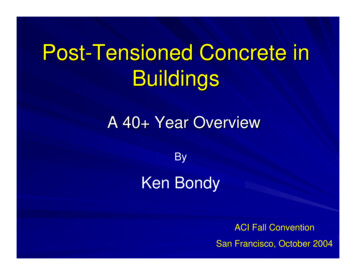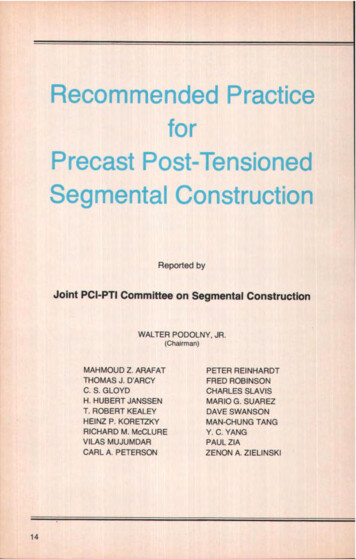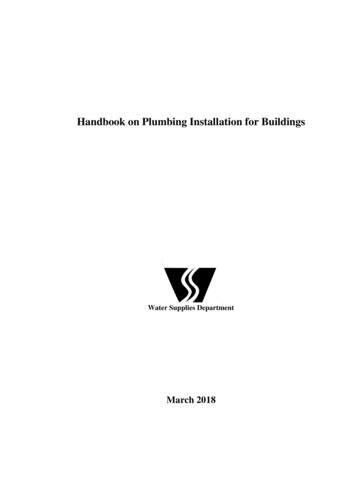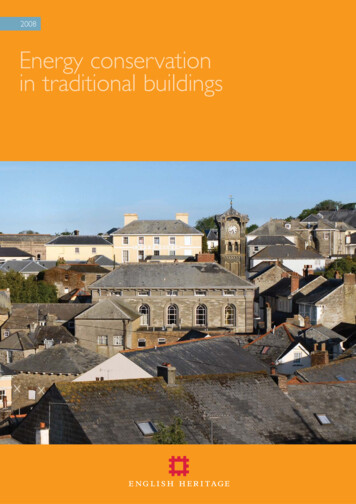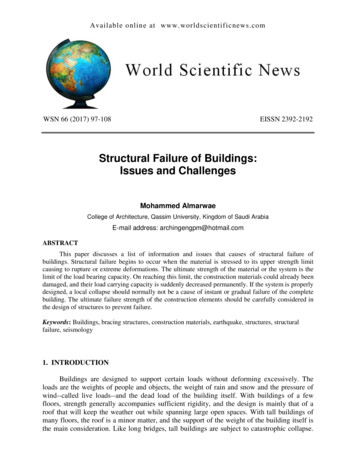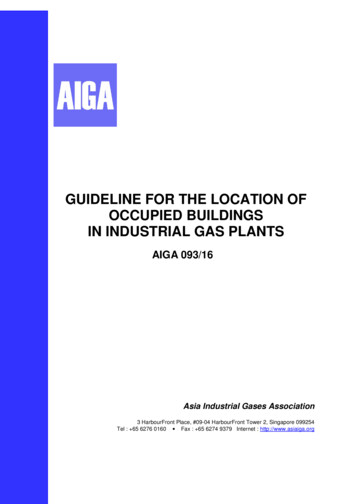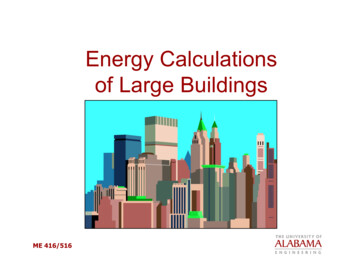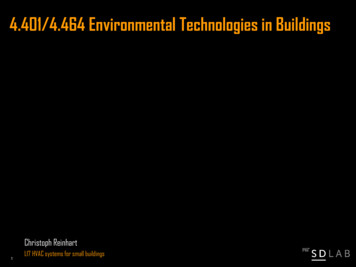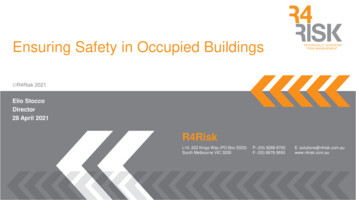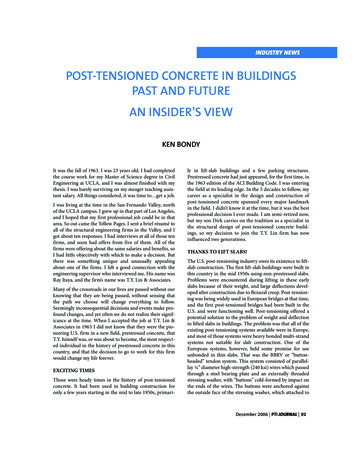
Transcription
Journal 012807 Case Histories w ad:Layout 12/1/20071:11 PMPage 91INDUSTRY NEWSPOST-TENSIONED CONCRETE IN BUILDINGSPAST AND FUTUREAN INSIDER’S VIEWKEN BONDYIt was the fall of 1963. I was 23 years old. I had completedthe course work for my Master of Science degree in CivilEngineering at UCLA, and I was almost finished with mythesis. I was barely surviving on my meager teaching assistant salary. All things considered, it was time to get a job.I was living at the time in the San Fernando Valley, northof the UCLA campus. I grew up in that part of Los Angeles,and I hoped that my first professional job could be in thatarea. So out came the Yellow Pages. I sent a brief résumé toall of the structural engineering firms in the Valley, and Igot about ten responses. I had interviews at all of those tenfirms, and soon had offers from five of them. All of thefirms were offering about the same salaries and benefits, soI had little objectively with which to make a decision. Butthere was something unique and unusually appealingabout one of the firms. I felt a good connection with theengineering supervisor who interviewed me. His name wasRay Itaya, and the firm’s name was T.Y. Lin & Associates.Many of the crossroads in our lives are passed without ourknowing that they are being passed, without sensing thatthe path we choose will change everything to follow.Seemingly inconsequential decisions and events make profound changes, and yet often we do not realize their significance at the time. When I accepted the job at T.Y. Lin &Associates in 1963 I did not know that they were the pioneering U.S. firm in a new field, prestressed concrete, thatT.Y. himself was, or was about to become, the most respected individual in the history of prestressed concrete in thiscountry, and that the decision to go to work for this firmwould change my life forever.EXCITING TIMESThose were heady times in the history of post-tensionedconcrete. It had been used in building construction foronly a few years starting in the mid to late 1950s, primari-ly in lift-slab buildings and a few parking structures.Prestressed concrete had just appeared, for the first time, inthe 1963 edition of the ACI Building Code. I was enteringthe field at its leading edge. In the 5 decades to follow, mycareer as a specialist in the design and construction ofpost-tensioned concrete spanned every major landmarkin the field. I didn’t know it at the time, but it was the bestprofessional decision I ever made. I am semi-retired now,but my son Dirk carries on the tradition as a specialist inthe structural design of post-tensioned concrete buildings, so my decision to join the T.Y. Lin firm has nowinfluenced two generations.THANKS TO LIFT SLABS!The U.S. post-tensioning industry owes its existence to liftslab construction. The first lift-slab buildings were built inthis country in the mid 1950s using non-prestressed slabs.Problems were encountered during lifting in these earlyslabs because of their weight, and large deflections developed after construction due to flexural creep. Post-tensioning was being widely used in European bridges at that time,and the first post-tensioned bridges had been built in theU.S. and were functioning well. Post-tensioning offered apotential solution to the problem of weight and deflectionin lifted slabs in buildings. The problem was that all of theexisting post-tensioning systems available were in Europe,and most of those systems were heavy bonded multi-strandsystems not suitable for slab construction. One of theEuropean systems, however, held some promise for useunbonded in thin slabs. That was the BBRV or “buttonheaded” tendon system. This system consisted of parallellay ¼” diameter high-strength (240 ksi) wires which passedthrough a steel bearing plate and an externally threadedstressing washer, with “buttons” cold-formed by impact onthe ends of the wires. The buttons were anchored againstthe outside face of the stressing washer, which attached toDecember 2006 PTI JOURNAL 91
Journal 012807 Case Histories w ad:Layout 12/1/20071:11 PMPage 92Fig. 1 – Button-Headed (BBRV) Anchoragea hydraulic ram which elongated the wires and applied thestress. The prestress force was held by steel shims insertedbetween the stressing washer and the bearing plate. Thebutton-headed anchorage is shown in Fig. 1:To address the problems of weight and deflection, each ofthe early lift-slab companies went to Europe and returnedwith a license to fabricate and use an unbonded BBRV tendon system. Some “independent” companies (not involvedin lift-slab construction) also obtained BBRV licenses andbegan to engage in the general marketing of post-tensionedbuildings, those included Prescon, Ryerson, AmericanStress-Wire, and a few others.Post-tensioning slabs in lift-slab buildings reduced theirweight by about 30%, making lifting easier, and solved thedeflection problems. For a short time the lift-slab industrythrived and many quality lift-slab buildings were built.However, while solving some problems, the button-headedtendon system created others. First, since both dead-endand stressing-end anchorages were attached in the factory,button-headed tendons had to be fabricated to a preciselength between slab edge forms, with very little tolerance.If the as-delivered tendon length was shorter or longer than92 PTI JOURNAL December 2006the length between edge forms, either the tendon had to bereplaced with another one of the correct “exact” length, orthe edge forms had to be moved.Next, button-headed tendons required some type of stressing pocket at their stressing-end to cover the shims andstressing washer which protruded out from the bearingplate. Some contractors used a continuous edge strip tocover the anchorages; others preferred a “saw-tooth”arrangement with a pocket at each anchorage. But in bothcases a second concrete pour was required to fill the pockets or the continuous edge strip.Finally, button-headed tendons required bulky and expensive couplers when intermediate stressing was required.The coupler was usually provided in the form of a largehigh-strength steel stud, externally threaded, that screwedinto an internally threaded hole in the stressing washer.Tendon friction in wire tendons at that time limited stressing lengths to about 80 feet from one end and twice that, orabout 160 feet from two ends. Any building longer than160 feet in either direction therefore required an intermediate construction joint, intermediate tendon stressing, andexpensive couplers. Most buildings required such a joint.
Journal 012807 Case Histories w ad:Layout 12/1/20071:11 PMTHE FIRST STRAND POST-TENSIONING SYSTEMThe first strand post-tensioning system used in the U.S.was developed in the early 1960s by Edward K. Rice, thepresident of T. Y. Lin & Associates. The T. Y. Lin firm didconsulting work for many precast concrete plants, and ofcourse they all used seven-wire strand for prestressingsteel, anchored at the bulkheads with various types ofwedge anchors. T. Y. Lin & Associates had begun designing buildings with some post-tensioned members, and Edwas keenly aware of the construction problems with thebutton-headed tendons on those projects. Through hisfamiliarity with the use of strand in precast/prestressedconcrete members, he also recognized that the use of astrand system with wedge anchorages would solve all ofthe problems inherent in the button-headed system.Responsive to all of this Ed designed and patented thefirst wedge anchorage for use with seven-wire strand inpost-tensioned applications. He formed a separate company to market the strand system. That company wascalled Atlas Prestressing Corp. Ed sold Atlas to Harold D.Long, a young engineer working for T. Y. Lin & Associatesat the time, and Hal became its first chief executive. Atlaswas based in Van Nuys, California. Through my designwork at T. Y. Lin & Associates I became enthralled withpost-tensioned concrete as a structural system, and familiar with Atlas as a company. I joined Atlas in 1965, afterabout three years with T. Y. Lin & Associates.Atlas, under Hal Long’s leadership, introduced the strandpost-tensioning system to the U.S. construction market in1962. Although competition with the button-headed tendon firms was fierce, Atlas met with much successbecause the strand system eliminated all of the construction problems inherent in the BBRV tendons. The strandsystem did not require exact length; the strand could becut a few feet longer than the finished slab length; and theexcess strand was simply trimmed off after stressing. Thestrand anchorages did not require formed stressing pockets or edge strips. A small two-piece round rubber “grommet”, positioned between the anchorage and the finishededge form, recessed the anchorage a few inches backinside the slab from the edge. When the grommet wasremoved after concrete placement, it formed a round holeinto which the jack nosepiece was placed when the strandwas stressed. A portion of the grommet also filled up thespace inside the anchorage, preventing ingress of cementpaste from the back of the anchorage during concreteplacement. After stressing and cutting off the excessstrand just inside the finished face of the concrete, thesmall hole was simply filled with grout and finished flushwith the slab edge. Stressing at intermediate constructionjoints was easy, the strand was cut to the full length of theslab and an intermediate anchorage was simply slid ontothe strand and stressed at the intermediate constructionPage 93joint using open-throated stressing jacks. The remaininglength of tendon was then rolled out into the next pour.That is not to say that the first strand system was completely problem-free. The first strand-wedge anchorageconsisted of a coil of high-strength wire with a taperedshape to receive the wedges. It is shown in Fig. 2:Fig. 2 – Coil AnchorageThere was no bearing plate used with this anchorage, thesmall steel plate shown was used only to attach theanchorage to the forms with nails passing through thenail-holes. The prestressing force was transferred to theconcrete not by bearing but by the direct tensile resistanceof the concrete to the lateral forces generated by thewedges on the inside surface of the coil. This required significant concrete tensile strength in the anchorage zone.Many concrete breakouts occurred when coil anchorageswere stressed. These breakouts were particularly prevalent in lightweight concrete, which was widely used inCalifornia in the 1960s. It became obvious to Hal Longthat the coil anchorage had to be replaced with a bearingtype anchorage. Dick Martter, an extremely talentedmechanical engineer and one of the first Atlas employees,stepped up to the plate and, with help from Hal, developed the first ductile iron casting. It went into service forthe first time in 1965, the year I joined Atlas. The use ofductile iron, a casting material with ductile properties,permitted a bearing plate surface to be combined with the“barrel” ring containing the tapered hole housing thewedges in a single casting piece. The development of theductile iron casting was a huge event in the history ofpost-tensioned building construction, and ductile ironcastings similar to the original design by Martter continue to be used as the industry standard today.December 2006 PTI JOURNAL 93
Journal 012807 Case Histories w ad:Layout 12/1/20071:11 PMTHE BATTLE BETWEEN STRAND SYSTEMS ANDBUTTON-HEADED WIRE SYSTEMSContractors quickly recognized the advantages of thestrand system, and with a philosophy of good service anddissemination of structural design information to practicing structural engineers, Atlas grew rapidly. However competition from the established button-headed tendon firmswas vicious. It was Atlas versus everybody else, and after afierce five to six-year struggle, Atlas eventually won thebattle of the marketplace by the late 1960s, and all of thesurviving button-headed tendon firms switched to strandsystems. Button-headed tendons became extinct in the U.S.construction industry and virtually all post-tensioning inbuilding construction has been with strand tendons withwedge anchorages since 1970. In a ten-year period fromthe mid 1960’s to the mid 1970s Atlas grew from the smallest to the largest of the U.S. post-tensioning firms withdivision offices throughout the country and an operationin western Europe based in Amsterdam.WHAT HAPPENED TO LIFT-SLABS?The concept of lift-slab buildings was a good one. It eliminated concrete forming, a major component of concretebuilding cost, and had many other inherent advantages.The cost of the specialized equipment could be amortizedover many buildings. However the lift-slab companies, inmy opinion, made a fatal marketing mistake which foreveraffected their penetration into the construction market.They combined the cost of the lifting with the cost of thetendons into one bid price which was provided to the general contractors on each new building project. This meantthat independent post-tensioning companies could not bidon lifted projects. The lifting companies would not exposethe tendon price, and therefore a tendon bid submitted byan independent post-tensioning company was meaninglessbecause there was nothing with which to compare it. Thishad short-term advantages for the lifting companies; itallowed them to shield their tendon prices from competition from other tendon firms. But the practice had seriouslong-term consequences for the lifting industry, and eventually resulted in the downfall of what could have been amajor construction industry.Since independent tendon companies were excluded frombidding on lift-slab projects, our company, AtlasPrestressing Corp. decided to form alliances with theemerging flying form industry and provide a bid to thegenerals for a completely cast-in-place building. Joint promotion between Atlas, flying form companies, and progressive concrete contractors allowed direct competitionwith lifted buildings. The use o
The U.S. post-tensioning industry owes its existence to lift-slab construction. The first lift-slab buildings were built in this country in the mid 1950s using non-prestressed slabs. Problems were encountered during lifting in these early slabs because of their weight, and large deflections devel-oped after construction due to flexural creep. Post-tension-
